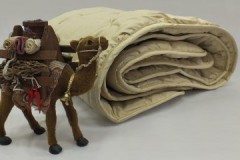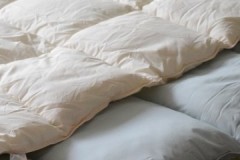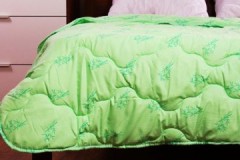Competent care: how to wash a padding polyester blanket and not ruin it?
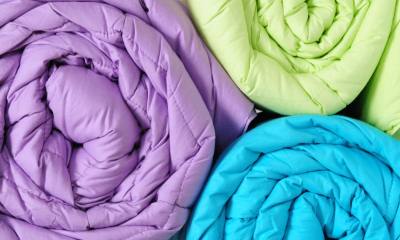 The synthetic winterizer blanket is lightweight and retains heat well. But during operation, it accumulates dust and sweat, therefore it requires periodic cleaning.
The synthetic winterizer blanket is lightweight and retains heat well. But during operation, it accumulates dust and sweat, therefore it requires periodic cleaning.
For proper care, you need to know how to properly wash a padding polyester blanket in order to maintain all its qualities and an attractive appearance.
Content
Can the garment be washed?
In the majority of cases, it is not only possible, but also necessary to wash synthetic winter blankets. You can learn about the processing features by the label on the product, so you should study it first.
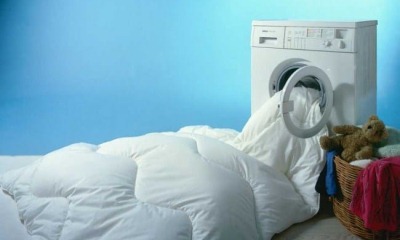 If the manufacturer allows both manual and machine washing, then you can choose the right one based on the following factors:
If the manufacturer allows both manual and machine washing, then you can choose the right one based on the following factors:
- the volume of the blanket;
- the size of the drum of the washing machine;
- personal preferences;
- the degree of wear and tear of the thing;
- the presence of stains, etc.
If a washing blankets - first, it is necessary to inspect not only the label, but also the product itself. Some models have removable covers that are washed separately. This option is very convenient, as it avoids impact on the insulation.
Hand and machine wash have their pros and cons... Among the advantages of machining is a significant reduction in labor. But manual processing makes it possible to carefully clean the thing, paying attention to especially stained areas.
Top 3 best remedies
It is better to choose detergents for processing blankets on synthetic winterizer in gel form. They dissolve faster than powders and are easier to rinse out of synthetic filler fibers.
Persil Professional New gel
The universal washing gel instantly dissolves in water and penetrates deep into the fibers. The price of a large bottle of 5 liters. - about 1,000 rubles.
The gel does not leave streaks and protects the parts of the washing machine from limescale.The highly concentrated formula allows an economical use of a product that is suitable for both hand and automatic washing.
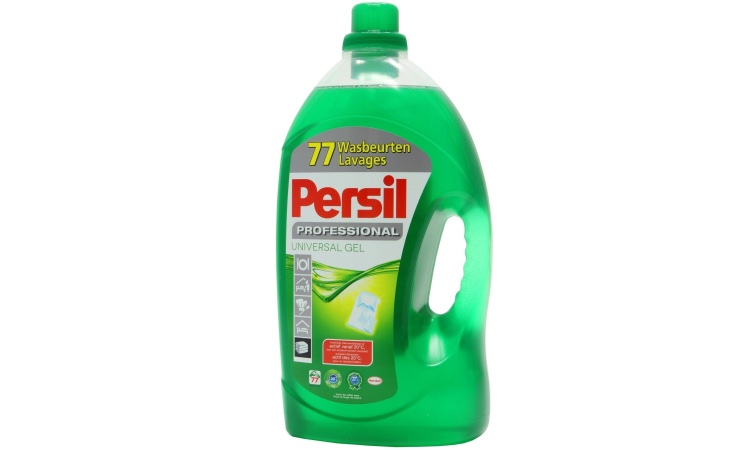
Snow guard
The gel is intended for washing blankets and clothes that contain synthetic winterizer, as well as feathers and down. The drug is conveniently measured with a cap. Snow Guard can be used for both machine and hand wash. The cost of a bottle is 1 liter. - 500 rubles.
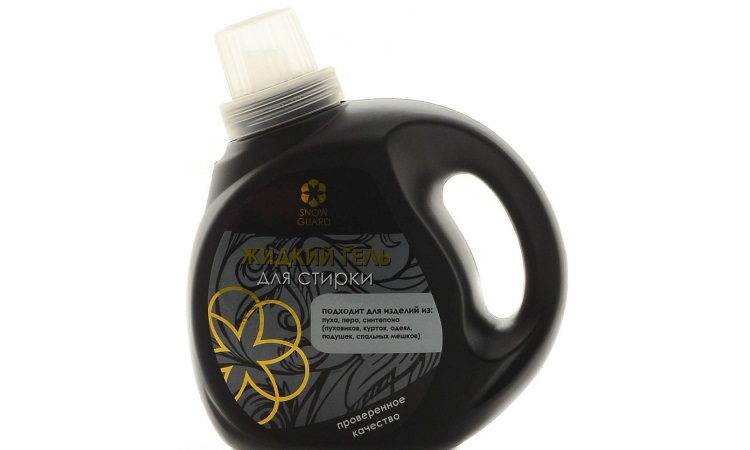
Batel gel universal
The product can be used for washing synthetic materials, including blankets on synthetic winterizer. The gel is gentle on the fibers, gives things a pleasant aroma and effectively fights dirt. Price - about 360 rubles per 1 liter package.
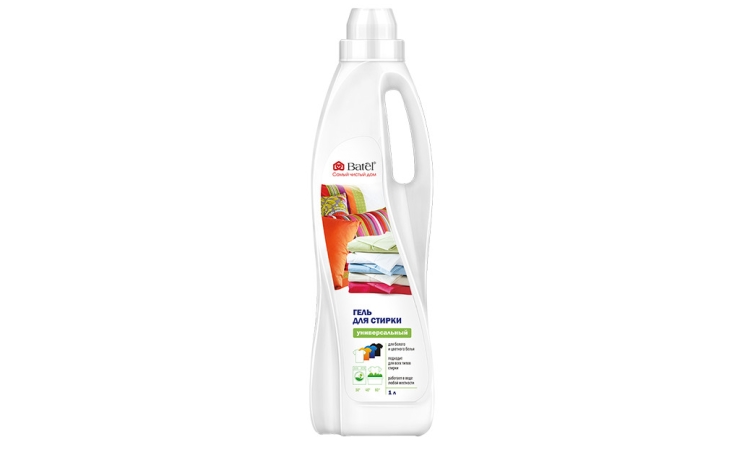
Processing rules in a washing machine
Washing in a typewriter is a convenient option that provides general processing of the entire thing. If there are stains or very dirty places on the product, then they should be cleaned before putting the thing into the drum.
Mode
Automatic washing machines have many washing modes. To care for blankets the most suitable are:
- "synthetics";
- "Voluminous things";
- "delicate wash".
Some units have a separate mode designed for washing large items (pillows, soft toys, etc.). For a padding polyester blanket, this option is optimal, as it provides both washing and thorough rinsing of soapy water from the fibers.
Temperature
If the manufacturer does not specify the temperature regime, or the label to the item is lost, then the temperature is chosen about + 40 ° С... Hotter water can damage the insulation. And cold - will make washing ineffective.
Spin: is it necessary or not?
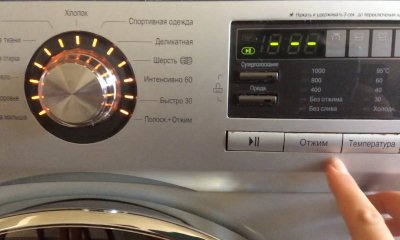 The blanket can be lightly wrung out, or you can not use this mode. It should be borne in mind that without squeezing out the water, the thing will get out of the washing machine wet, from which water will literally pour.
The blanket can be lightly wrung out, or you can not use this mode. It should be borne in mind that without squeezing out the water, the thing will get out of the washing machine wet, from which water will literally pour.
When you set the spin, a significant part of the moisture will be removed, and the product dries more easily and quickly. But the number of revolutions should be set to 800.
Sequencing
Processing in a washing machine should be carried out in accordance with the following sequence of actions:
- Study of the label for the product.
- Erasing stains.
- The blanket itself is rolled and folded so that it fits into the drum effortlessly.
- The mode is set to "bulk items" or "synthetics".
- The temperature is adjusted. Should be around + 40 ° C.
- Spin - 400-600 rpm.
- Set the "additional rinse".
Manual cleaning
Hand washing is a laborious process. It is chosen when:
- you need to pay attention only to individual areas;
- the blanket must not be machine washed;
- the item does not fit into the drum of the compact washing machine.
For a large blanket, a bath tub will work as a washing container.
Procedure:
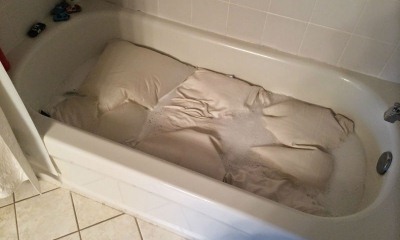 The bath is filled with water at a temperature of about + 30 ° C - + 40 ° C.
The bath is filled with water at a temperature of about + 30 ° C - + 40 ° C.- Dilute the detergent.
- The blanket is dipped in water and washed section by section using a brush. During processing, the item should be carefully turned over.
- After processing, the water is drained.
- Water is collected several times and drained again.
- Wring out.
During the washing process, the blanket absorbs a lot of water and becomes very heavy, which complicates both the washing itself and the subsequent spinning, as well as drying.
Removing stains
Any stain that appears on the product should be removed as soon as possible.so that it is not deeply absorbed into the fibers and does not get old.
If the stain has just appeared, it is recommended to wet the affected area with cold water to prevent its spread. If you know what exactly the stain is formed by, it will be much easier to deal with it.
Fat
Grease stains are one of the most common types of stains, especially in children. Residues from "snacks" can be neutralized with dishwashing detergent:
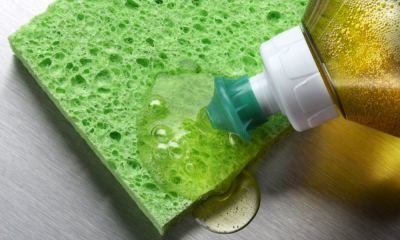 in a separate bowl, dilute it with a small amount of water to obtain a high concentration solution;
in a separate bowl, dilute it with a small amount of water to obtain a high concentration solution;- foaming;
- using a sponge, apply to the stain;
- let the blanket lie down;
- wash the affected area or wash the entire item if the area is large enough.
Learn more about how to remove greasy stains from fabric. this article.
Urine
You can remove urine from the blanket if act according to the following algorithm:
- Blot the surface with napkins.
- Dilute vinegar with water in a ratio of 1: 3.
- Spray the resulting solution onto the blanket from a spray bottle.
- Blot with a napkin.
- If there is a lot of moisture, then sprinkle soda on the stain and hold it for a quarter of an hour.
- Dilute hydrogen peroxide with water in a ratio of 1: 2.
- Spray the stain directly onto the baking soda. When soda and peroxide are combined, a chemical reaction will take place to form a foam.
- Leave on for 2 hours.
- Get wet, clean.
- Wash the blanket.
Blood
You can neutralize a fresh stain by washing it with cold water and treating it with hydrogen peroxide. When the reaction is over, the stain is washed off.
If a large area is affected, then a full wash will be required after processing... Read about ways to remove blood stains from fabric here.
Yellowed areas
Yellow stains on the blanket can be eliminated using a vinegar solution (diluted in water 1: 1) or lemon juice:
 stain remover with a sponge or sponge applied to the stain;
stain remover with a sponge or sponge applied to the stain;- withstand a quarter of an hour;
- wash away;
- if the stain remains, the process is repeated;
- the blanket is washed.
Correct washing and drying is one of the preventive measures. Moisture should not be allowed to stagnate and accumulate when drying things.
Alcoholic drinks
If a lot of liquid has been spilled, you should use napkins and blot the stain... Solvent - an agent that will help remove traces of the drink is an alcohol solution. You can apply alcohol by diluting it with water (1: 1) or vodka.
To remove the stain, it is advisable to use only alcohol or vodka, which have no shade. Any other alcoholic beverages are not suitable, as they themselves can stain.
How to dry?
The bulkiness of the blanket is difficult to dry. After washing (by hand or in a typewriter), the product is allowed to drain well... To do this, you can leave it in an empty bath for an hour.
If the item has been machine washed, then it can be left in it for 50-60 minutes by opening the door. This must be done, as in a closed drum, the blanket can acquire an unpleasant rotten smell.
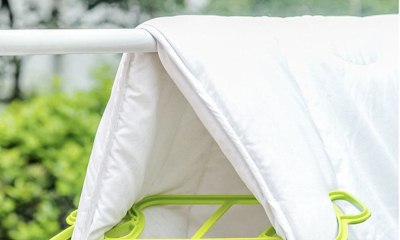 Thereafter:
Thereafter:
- wring out;
- shake;
- lay out;
- straighten with hands and stretch slightly.
During the drying process, it is advisable to spread the thing on a plane and periodically turn it over, shake it so that the filler fibers dry out evenly. Placing the blanket in the fresh air will speed up drying.
If the organization of drying at the moment according to all the rules is impossible, it is advisable to postpone it.Drying in the machine is not recommended.
Sintepon lost: problem solving and prevention
The synthetic winterizer is one of the fillers that tolerate washing well and practically do not go astray. This is due to the peculiarities of the material itself and the quilting.
In some cases, the insulation can be deformed and stray into lumps. These reasons are:
- violation of washing or drying technology;
- poor-quality sewing of a blanket;
- significant wear and tear of things.
In order to prevent damage to things during the washing process, you can use such preventive measures:
- Put a couple of tennis balls or special ones designed specifically for washing in the drum to the blanket.
- Quilting coarsely with your hands the areas of the blanket in which the synthetic winterizer is weakly fixed or not fixed at all.
If the deformation of the padding polyester has affected large areas, the blanket will have to be replaced.
Dry cleaning: when, where, how much?
 In cases where washing in a machine and by hand is prohibited, the blanket can be dry cleaned. Experts will help even when there is no time or conditions to wash and dry the blanket.
In cases where washing in a machine and by hand is prohibited, the blanket can be dry cleaned. Experts will help even when there is no time or conditions to wash and dry the blanket.
You can find a suitable dry cleaner on the Internet, according to customer reviews... The cost of the service may differ in different service establishments, even within the same locality.
The cost of cleaning depends on the size of the item. On average, a one-and-a-half blanket can be cleaned for 1,000 - 1,200 rubles, a double blanket - from 1,500 rubles. If additional repairs are needed, the amount increases.
In addition to the duvet, you can also dry-clean the pillows from the bed.
7 tips to help
Washing tips will help you do the job better and faster:
- For processing, it is best to choose a liquid detergent rather than a powder.
- Using stain removers is an undesirable cleaning option. The exception is blankets, for which the cover is removable and can be washed separately.
- Even small children's blankets on padding polyester are machine washed one by one.
- You can put tennis balls in the washing machine along with a blanket in the drum. They will prevent the filler from matting.
- Washing frequency - up to 3 times a year.
- An indication on the label that only dry cleaning is possible and that any type of washing is prohibited may indicate the use of low quality filler.
- Pulling out a blanket, or brushing a vacuum cleaner over it, is not an alternative to washing.
Conclusion
Regular washing will keep the padded quilt hygienic and safe for your health. It is important that you use the correct detergent and follow professional advice.

